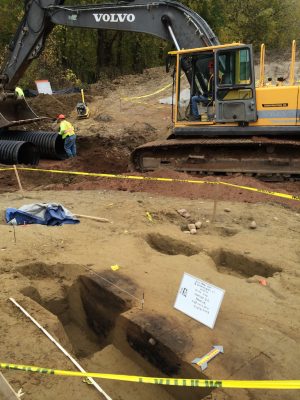
OSA as a Resource
The Office of State Archaeology provides guidance to municipalities and developers regarding matters of historic preservation – in particular those pertaining to buried archaeological resources. While the state site files list over 6,000 archaeological sites, it is estimated that these represent only about 2% of the total. This means that 98% of the state’s buried historical resources remain undocumented. These resources exist in every community and range in size and complexity from small 12,00 year old tool manufacturing locations to early 20th century mill complexes covering acres of ground. OSA is responsible for the review of municipal level projects. If you have questions about state or federal projects, please contact Deputy SHPO Catherine Labadia at Catherine.labadia@ct.gov.
OSA recommends that all towns develop an archaeological sensitivity overlay so that proposed construction in areas of high sensitivity will initiate appropriate archaeological survey work to be sure the community’s historical resources are appropriately documented. While OSA can aid in the development of such a plan, it is recommended that towns hire a professional Cultural Resource Management firm to appropriately document the town’s known resources and establish areas of high probability for the presence of unidentified resources. The State Historic Preservation Office provides Survey and Planning grants that can help meet the costs of developing such a planning tool. This tool is only as effective as the local regulations developed to implement it. Therefore OSA recommends that P&Z offices develop local ordinances that establish protocols for archaeological review prior to construction. These should fall under the same general regulations governing the environmental review process. OSA has standard sample regulatory language that towns can adopt for their own use, and is happy to work with municipalities to draft their own language that best meets their local needs. Once such local regulations are in place, the Office of State Archaeology will review projects in coordination with the municipal P&Z office to determine the need for an archaeological survey. More information for municipalities.
If you are a developer and have been informed by your P&Z that an archaeological survey is required, contact the state archaeologist Sarah Sportman at sarah.sportman@UConn.edu. Please be prepared to submit a pdf of your project plans as an attachment to your email that describes the scope of the proposed project. This plan should indicate all areas of potential ground disturbance, including building footings, septic systems, utilities, parking areas and driveways, as well as areas to be graded. Digital plans are preferred over paper ones as they are easier to incorporate into OSA’s GIS. I will review these plans and let you and P&Z know if an archaeological survey is necessary. If the area appears sensitive to the presence of archaeological resources, I will recommend an archaeological survey. Don’t worry – the presence of archaeological resources has not prevented development, and most surveys can be conducted quickly, depending on the scope of the survey required. Because the Office of State Archaeology conducts the review and does not have staff to conduct archaeological surveys, it is necessary that developers seek an outside party to conduct this work. OSA will work with the developer and CRM firm to develop a survey strategy that keeps the costs of a survey as low as reasonably possible. If an important archaeological site is identified, OSA will recommend that the location be protected in place. If that is not feasible, OSA may at that point request permission to conduct a salvage excavation. More information for developers.
A Guide to Legislative Citationshttp://www.cac.uconn.edu/osa_downloads.html
 Loading...
Loading...
Planning and Zoning Strategies: Protecting Connecticut’s Archaeological Resources, CRM No. 10, 1998
